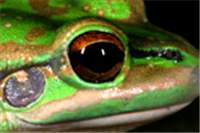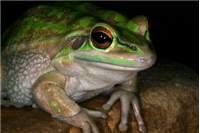Family
Hylidae
Genus
LitoriaSpecies
aurea
Local/Urban Actions
The Department of Environment and Heritage currently has a recovery plan in process for the species (http://www.deh.gov.au/biodiversity/threatened/action/frogs/7.html).
Distinguishing Features
Adults range from 5.3-10cm in length. As the ©green and golden© common name suggests, the species often has green and gold markings on the back, with the ratio of green to gold/brown blotches varying between individuals. A gold/brown stripe extends from the nose or eye angling to the groin, this is highlighted by a black stripe that starts at the nose, runs beneath the paler stripe and follows the same line. The thighs are purple to blue in colour. The call of Litoria aurea is not very loud, described as a drawn out ©wrrraaaaagh wrrraaaaagh wrrrkk, wrrkkk wrrkk©, similar to the noise of a motorcycle changing gears. Tadpoles are translucent yellow with a triangular dark marking between the eyes.
Common name/s
Green and Golden Bell Frog, Swamp Frog, Smooth Swamp Frog, Green and Golden Swamp Frog
Similar Species
Although similar in call and colour to the closely related the Southern Bell Frog ( Litoria raniformis), the Green and Golden Bell Frog has smooth skin on its back, while the skin on the back of the Southern Bell Frog is warty and rough. Eggs are found in floating jelly rafts in water bodies.
Distribution
Extends throughout eastern NSW and Victoria.
Country of Origin
Australia
Survey Techniques
The most common technique for monitoring frog populations is based on call identification, with each frog species having a unique call. Although Litoria aurea is unusual as it is active during the day the easiest way to detect the species is still by call identification. Frogs drink and breathe through their skin and are very sensitive to chemicals in their environment. Where possible, you should not handle frogs, as the natural bacteria on your hands or chemicals such as sunscreen can damage their skin and cause illness or death.
Conservation (Pet/Pest) Status - National
In decline. Population size thought to be in decline over the last 50 years.
Conservation (Pet/Pest) Status - Regional
Endangered. Thought to have disappeared from its former range within the southern tablelands. Listed as an endangered species under the NSW Threatened Species Conservation Act 1995.
LSCCES Population
Extinct. This species was not detected in the 2004 ACT Frogwatch census.
Associated Vegetation Community
Vegetated zones of permanent water bodies. Associated plants include bulrushes Typha sp and spike-rushes Eleocharis sp, reeds and sedges.
Limiting Resources
Not thought to occur above 700m altitudes. Prefers slow moving, permanent water bodies. Siting records suggest the species requires dense vegetation including rushes and reeds.
Breeding
Calls from August through to January, with breeding occuring from October to January. Eggs are found in large floating jelly rafts up to around 30cm in diametre, that eventually sink to bottom of the waterbody.
Behaviour
Active during both the day and night. Known to bask directly in sunlight. A semiaquatic species.
Functional Group
Insectivorous, carnivourous, cannibalistic
Food Species
Frogs including their own species, insects
Predators
Several animals are known to eat the species including native turtles, snakes, wading birds and fish. The introduced species such as the fish Mosquito Fish/Eastern Gambusia (Gambusia holbrooki) is listed as a threatening process towards as this fish eats both tadpoles and eggs of the species.
Interesting Fact
The development of the site of the Sydney 2000 Olympics rose the profile of L. aurea prompting a campaign to save it.
References - (reader suitability of references, P=Primary teachers, S=Secondary students, T=Tertiary students and researchers)
Books:
Barker, J., Grigg,G., Tyler, M. (1995). A Field Guide to Australian Frogs. Surry Beatty & Sons. NSW, Australia. S, TLintermans,M. & Osborne, W. (2002). Wet & Wild: A Field Guide to the Freshwater Animals of the Southern Tablelands and High Country of the ACT and NSW. Environment ACT. Canberra, Australia. S, TRobinson, M. (1993). A Field Guide to Frogs of Australia. Australian Museum/Reed books. NSW, Australia. S, TTurner, J. (2004). Frogs of Australia. Pensoft. Bulgaria. P, STyler, J. (1994). Australian Frogs: A Natural History. Reed New Holland. Australia. S, TSwan, G.(2001). Green Guide: Frogs of Australia. New Holland Publishers. Sydney, Australia. P, S
Online Publications:
Amphibian Research Centre. (2005). Available Online: http://frogs.org.au/frogs/species/Litoria/aurea/ S, TAustralian Frogs Database.(2005). Available Online: http://frogsaustralia.net.au/frogs/display.cfm?frog_id=132 S, TDepartment of Environment and Heritage, (2004) Chytridiomycosis Factsheet http://www.deh.gov.au/biodiversity/invasive/publications/c-disease/ S, TEnvironment ACT. (2004). Summary of results. Available online: http://www.environment.act.gov.au/Files/frogwatchoctober2004summary.pdf P, S, TNSW Parks and Wildlife Service. (1999). Threatened Species Information: Green and Golden Bell Frog. Available online: http://www.nationalparks.nsw.gov.au/pdfs/tsprofile_green_golden_bell_frog.pdf S, TZoological Parks and Gardens Board. Frog Pond Checklist. Available Online: http://www.zoo.org.au/education/factsheets/amp-frog_pond_checklist.pdf P, S, TSpeare, R et al (1998). HOW TO REDUCE THE RISKS OF YOU TRANSMITTING AN INFECTIOUS AGENT BETWEEN FROGS AND BETWEEN SITES. Available Online: http://www.jcu.edu.au/school/phtm/PHTM/frogs/prevent.htm S, TTyler, J. & Department of Environment and Heritage. (1997) The Action Plan for Australian Frogs: Recovery Outline No. 1: Green and Golden Bell Frog. Available online: http://www.deh.gov.au/biodiversity/threatened/action/frogs/7.html S, TZoological Parks Board N>S>W. (2005.). ASX Frog Focus. Available online: http://www.asxfrogfocus.com/ P, S (School activity program)
Researcher: Pippa Jaminon



 Top
Top Top
Top